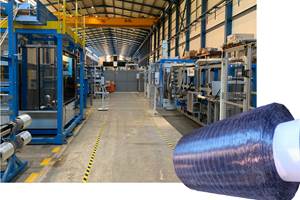Personal aircraft and composites at EAA AirVenture 2018
Many of the aircraft at the AirVenture 2018 show in July 2018 were composites-intensive and represent innovative designs and concepts.
“A ‘perfect’ event may be unattainable, but AirVenture 2018 came about as close as one could imagine,” says Experimental Aircraft Assn. (EAA, Oshkosh, WI, US) chairman Jack Pelton. Given the combination of outstanding programs, aircraft variety, a robust economy and good weather, the week-long event, held July 22–28, attracted approximately 601,000 people, nearly 2% more than 2017’s attendee record. More than 10,000 aircraft arrived at Wittman Regional Airport in Oshkosh and other airports in east-central Wisconsin. Wittman alone saw approximately 134 takeoffs/landings per hour. More than 75,000 people attended 1,500 forums, workshops and presentations, some of which involved composite materials and fabrication.
Many of the aircraft at the show were composites-intensive and represent innovative designs and concepts. One of these was exhibited by Terrafugia (Woburn, MA, US, a subsidiary of China’s Zhejiang Geely Holding Group, which owns Volvo, Lotus, and other international auto brands), founded in 2006. Under its new ownership it is now positioning itself as a major player in the realm of automated vertical takeoff and landing (VTOL) urban air mobility vehicles and “personal on-demand aviation.” At the show, it announced major design enhancements for the Transition, its in-development, two-place flying car that flew at Oshkosh five years ago, and also introduced its next transportation concept, a VTOL aircraft for passenger and cargo transport.
First, the existing D2 Transition will be replaced soon by a Flight Assessment Vehicle for certification, which will incorporate the enhancements announced at the show. Among these enhancements: road driving power provided by a combination of an internal combustion engine and a LiFePO4 (lithium iron phosphate chemistry) battery — a safer technology than other lithium battery chemistries, says Terrafugia. In flight mode, a boost feature will be added to the throttle for brief bursts of extra power. A full frame parachute system will also be added.
The company has never given up in its quest for a flying car: “Developing this new technology has allowed us to test several different mechanisms and generate process improvements along the way,” says Terrafugia CEO Chris Jaran. “We are at the critical point where we can implement the best design features based on years of flight and drive testing. This will improve function, safety and aesthetics for the optimal flying and driving experience.” The new features will enable the Transition to meet all US Federal Aviation Admin. (FAA) and US National Highway and Traffic Safety Administration (NHTSA) safety standards, while optimizing the flight experience for both pilot and passenger. Terrafugia says the first production vehicles will come to market in 2019.
At the show, Terrafugia also introduced an integrated system designed for urban air transportation applications. The TF-2 consists of a hybrid-electric VTOL aircraft; a ground transportation vehicle; and a passenger (or cargo) pod that can be transported by the ground vehicle or slung under the VTOL. For on-demand people-moving, the concept calls for the ground vehicle carrying a passenger pod to pick up four passengers with luggage and transport them in the pod to a “vertiport,” and attach the pod to the VTOL (within 2 minutes) that will carry them by air to another vertiport. Another ground vehicle will then accept the pod and transport it the last mile to the final destination. TF-2 will be piloted, and initially have a hybrid-electric drive; all-electric propulsion will eventually be incorporated as the technology matures, says Terrafugia. With a payload of 900-1,100 lb, maximum speed is projected at 120-130 knots and the anticipated range is 170-215 nautical miles.
Samson Motors’ (Redmond, OR, US) carbon fiber composite Switchblade, introduced last year, was on display again. Company CEO Sam Bousfield announced that, at the show, reservations surpassed the 700 level, so interest is high. Bousfield told the crowd, as reported by David Tulis of Aircraft Owners and Pilots Assn. (AOPA), that the Switchblade will fly later this year.
And there were more “personal aviation” vehicles on display. One of these concepts, in its Oshkosh debut, was BlackFly (version 2), a VTOL battery-electric personal air vehicle (PAV) by Opener (Palo Alto, CA, US). The odd-looking craft with two wings has already, says the company, logged 12,000 miles in more than 1,400 test flights. A streamlined single-seat cabin with a rounded bottom and glass canopy on top is attached to a forward and a rear wing, with the front wing slightly shorter than the rear. Overall dimensions are 4.2m wide, 4.1m long and 1.5m high. Each wing supports four horizontal propellers, driven by electric motors powered by batteries. Four pairs of elevons (control surfaces that combine the functions of elevators and ailerons) provide flight control.
Classified as an ultralight aircraft, which means that the operator does not have to obtain a pilot’s license, the BlackFly weighs only 313 lb empty, with a maximum payload of 250 lb. The vehicle has a 25-mile range and a 62-mph cruise speed (in the US; European rules allow faster flight). The BlackFly can be recharged via solar panels, which come with the craft’s small transport trailer; Opener says an 80% charge is possible in 25 minutes. The vehicle can be disassembled in 30 minutes for ground transport within the trailer, and it is amphibious, with takeoffs and landings possible on water as well as smooth grassy surfaces — no airfield needed. The BlackFly’s light weight is thanks in large part to carbon fiber/epoxy prepreg construction. The company claims that the craft uses 245 watt-hours per mile (wh/mi), compared to a gasoline powered car at 1233 wh/mi, and that noise is comparable or slightly less than the noise made by a typical car or a motorcycle at highway speed. An interesting video at Opener’s Web site shows the craft being flown.
If rotorcraft is your preference, Safari Helicopter (Marianna, FL, US) showed its ultralight class Safari 400 and Safari 500 helicopter kit-built craft. Safari Helicopter has been in business for nearly 60 years under a succession of names, and its current owners showed at Oshkosh 2018, for the first time, a carbon fiber composite cabin, as an option to replace sheet metal (the cabin frame is chromoly steel tubing). Rotor blades are also carbon fiber composite/extruded aluminum.
Another personal helicopter already familiar to CW readers was on display again: the short-hop Surefly VTOL craft from Workhorse (Loveland, OH, US). The company’s goal is to make SureFly safer and more stable than a typical helicopter with redundant design, which includes four folding carbon fiber composite propeller arms, two fixed contra-rotating propellers on each arm, a backup battery system to drive the electric motors in the event of engine failure and a ballistic parachute that safely brings down the craft if needed. The SureFly’s fuselage and propellers are made of carbon fiber composites to provide lightweight and durability.
EAA is already looking ahead to the 2019 event, to be held July 22-28, says Pelton. “We are celebrating our 50th consecutive year in Oshkosh during 2019, so we’ll be planning activities that involve EAA’s hometown and its unique place in aviation history. We’re looking forward to announcing features and attractions very soon.”
Related Content
Materials & Processes: Fibers for composites
The structural properties of composite materials are derived primarily from the fiber reinforcement. Fiber types, their manufacture, their uses and the end-market applications in which they find most use are described.
Read MoreNovel dry tape for liquid molded composites
MTorres seeks to enable next-gen aircraft and open new markets for composites with low-cost, high-permeability tapes and versatile, high-speed production lines.
Read MoreThermoplastic composites welding advances for more sustainable airframes
Multiple demonstrators help various welding technologies approach TRL 6 in the quest for lighter weight, lower cost.
Read MoreThe making of carbon fiber
A look at the process by which precursor becomes carbon fiber through a careful (and mostly proprietary) manipulation of temperature and tension.
Read MoreRead Next
CW’s 2024 Top Shops survey offers new approach to benchmarking
Respondents that complete the survey by April 30, 2024, have the chance to be recognized as an honoree.
Read MoreComposites end markets: Energy (2024)
Composites are used widely in oil/gas, wind and other renewable energy applications. Despite market challenges, growth potential and innovation for composites continue.
Read MoreFrom the CW Archives: The tale of the thermoplastic cryotank
In 2006, guest columnist Bob Hartunian related the story of his efforts two decades prior, while at McDonnell Douglas, to develop a thermoplastic composite crytank for hydrogen storage. He learned a lot of lessons.
Read More


































